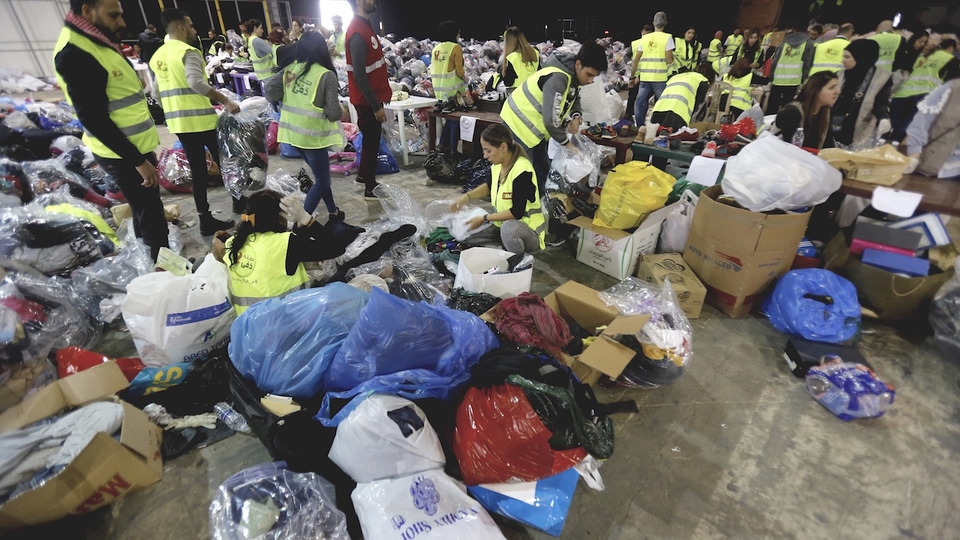Beyond Charity: Our Critical Need for Mutual Aid (Part 1 of 2)
Day 67: Sunday, December 22, 2019
The economic distress in Lebanon continues unabated: prices are rising, the dollar is trading up to 2,300 L.L. (a de facto devaluation of almost 35 percent), unofficial capital control keeps people cash strapped and desperate, and fears of fuel, medicine, and food shortages are widespread. This deterioration affects all, but it spells disaster for the 1.5 million Lebanese (28.5 percent of the population) who live below the poverty line, and for the vast proportion of refugees and migrants. The recent suicides of men who were unemployed, broke, or indebtehave added urgency to the search for immediate support as well as long-term, equitable solutions.
State provision cannot be trusted to provide social protection and essential life services, as most of the members of the political class are corrupt individuals who have lined their pockets with the money intended for public use. Ungluing politicians from their seats is a crucial goal, but given how dire the situation is, and how consolidated power is at the top, it cannot be the sole focus. So what options exist outside of state provision?
One form of aid that must be addressed, as it is a vital component of Lebanon’s corrupt political system, are the welfare programs, services, goods, and funds allocated by sectarian parties. This is a particularly dangerous form of aid for the current revolutionary movements since it perpetuates both clientelism and sectarianism. Social service providers linked to sectarian groups have been found to allocate benefits and services in modes that are discriminatory (along partisan and sectarian lines), to undercut the political voice of the poor by weakening alternative channels of claim making, and to produce and reinforce social inequalities.
Non-governmental organizations (NGOs) have, in some instances, filled gaps in state provision by attracting foreign funding and reaching communities ignored by the state. Charities too have served a support function, providing impoverished communities with basic necessities. Yet these two aid structures are problematic. For one, their giver-receiver nature replicates the Lebanese state’s class hierarchies. The givers, wealthier and more powerful members of society, make all the decisions of how much to give, what happens with the aid, and who receives it. The receivers, excluded from all decision-making, are left to accept what is given to them. Moreover, NGOs do little to challenge the economic and political structures that create the conditions that are their raison d’etre in the first place. NGOs even defuse the negative consequences of austerity and economic centralization, and blunt resistance to them, thereby allowing these policies to continue impoverishing communities further (Arundhati Roy writes beautifully on this subject). In short, NGOs and charities are not viable alternatives, but soothing remedies, pills to relieve the symptoms of the disease.
Since October, spontaneous grassroots actions have emerged. Free legal aid is being offered to protesters, food and clothing is being donated, soup kitchens have been handing out free food in Beirut's Martyrs’ Square and Tripoli's Al-Nour Square. Every day we see communities around Lebanon opening up their shops or creating food banks for people in need. These nascent initiatives reflect not just the generosity and goodwill of certain individuals, but also an awareness that they themselves must take the initiative. So far, however, these efforts operate on a giver-receiver basis; only a few of these initiatives have sprung directly from local communities organizing themselves around the aid they need. At this juncture, we need to examine how we can channel this energy into organized and lasting networks that can grow and be developed by the communities they aim to serve.
The strategy of combining resource allocation and community building is known as mutual aid. It consists of building community-led welfare networks that operate non-hierarchically and place those most oppressed at the center of the decision-making process. If NGOs and charities can be considered top-down forms of distribution, mutual aid consists of bottom-up organizing. Instead of wealthy donors dropping in sporadically to make decisions, organized local communities come together to collect and distribute aid amongst themselves. Crucially, the purpose of creating and contributing to mutual aid networks is not simply to help other people; it is to create strong, lasting, self-sustaining communities that can support all those within them.
The precise ways this will happen will depend entirely on each community. It will require them to organize, hold meetings, and decide for themselves what their needs are and what solutions will be necessary. The relationships that will form through these initiatives will not be transactional, as they are with charity. Instead, the logic is to develop communal bonds of solidarity that empower all its members. These solidarity communities usually emerge out of two conditions: by living close to and with other people (neighbours, townsfolk) or by being oppressed by the same societal forces (unions, queer community, women’s movement, etc.). At a time when protesters are calling for dismantling oppressive power structures, mutual aid is a way to build communities of solidarity with those oppressed by the structures. Moreover, by providing an alternative way to secure life essentials, mutual aid is one way to reduce the coercive power and leverage of the state.
Mutual aid is a form of self-organizing that bears immediate fruits. We do not have to wait for the government to collapse, nor do we not have to wait for approval from NGOs. We can start now by expanding on existing voluntary aid networks on the ground. If we organise locally around aid in a cooperative and non-hierarchical manner, perhaps not only will we survive this economic crisis, but we can further the goals of the revolution as well. Part 2 of this series will discuss mutual aid structures that are developing in Lebanon and how they can be improved upon based on historical and regional examples.
